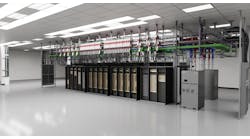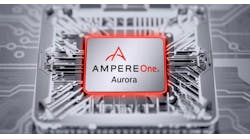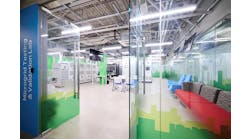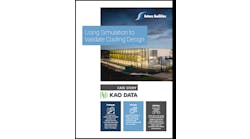Leading the Charge for Low-Carbon Green Concrete In Sustainable Data Center Construction
Further advancing foundations for tomorrow's sustainable, green building materials, Microsoft last week announced that its new concrete mixes, currently being tested by the data center research team at its Quincy hyperscale campus in central Washington state, are using a limestone derived from microalgae and other additives that lower the material's overall embodied carbon.
Microsoft said the Quincy project's goal is to test mix designs that can lower embodied carbon in concrete by more than 50%, as compared to traditional concrete mixes.
Channeling impetus from its $1 billion Climate Innovation Fund, launched in 2020 and comprising the company’s environmental commitments focused on carbon, water, waste and ecosystems, Microsoft reported that the concrete mixes currently being piloted by the company and its partners in Quincy include one which employs biogenic limestone, one using fly ash and slag activated with alkaline soda ash, and one combining both the alkali-activated cement and biogenic limestone.
The company added that the Quincy pilot project joins similar engagements with concrete suppliers in Des Moines, Iowa and San Antonio, Texas.
iMasons Climate Accord Sets Table for Data Center Net Zero
The market for low-carbon concrete was greatly strengthened by Infrastructure Masons' formation in early 2022 of the iMasons Climate Accord initiative, which sees Microsoft joining with fellow cloud giants Google, Amazon Web Services, and Meta, along with more than 70 data center builders and other companies, on the path to decarbonization and industry net zero.
The iMasons Climate Accord seeks new ways to track and reduce the environmental impact of the data centers that power the internet, as the industry moves toward mandatory Scope 3 accounting for GHG emissions by measuring how much carbon is embedded in all facets of a data center, from UPS batteries to the buildings' concrete and steel materials, as well as emissions from upstream and downstream in the supply chain.
An open letter from AWS, Google, Meta, and Microsoft submitted under the iMasons Climate Accord noted how "concrete, steel, and aluminum are responsible for 23% of total global carbon emissions, while concrete alone makes up 11% of total global emissions."
The open letter calls for the data center industry to work together to:
- Deliver a technology roadmap to decarbonize concrete.
- Set standard baselines to measure against.
- Drive transparency through Environment Product Declarations.
- Create a consistent method to calculate emissions in concrete.
The Ongoing Search for Sustainable Concrete
The search for a sustainable concrete mix has been previously piloted by Microsoft's hyperscale stablemate in the iMasons Climate Accord, Meta, who as reported by DCF in 2022, conducted a research project with the University of Illinois at Urbana-Champaign using artificial intelligence (AI) to create a sustainable concrete mix with greater strength and 40% lower carbon emissions. This concrete mix was then used in some of the construction of Meta’s data center campus in DeKalb, Illinois.
The global construction business has for some time been seeking ways to reduce the environmental impact of concrete production. A major component of concrete is cement, which requires the use of massive kilns, which require large amounts of energy. The actual chemical process of making cement also emits high levels of CO2. As a result, the cement in concrete accounts for approximately 8 percent of carbon emissions globally, as estimated by ISO.
A recent and notable industry blog by Stack Infrastructure reminds us that that the concept of green concrete was developed after the 1997 Kyoto Protocol, which incited international efforts to mitigate climate change by slashing greenhouse gas emissions. On the topic of green concrete for the data center industry, Stack's blog emphasizes:
"Concrete is so crucial to contemporary development that the world produces 32 billion tons of it each year. With a compound annual growth rate (CAGR) of 10.99% from 2021 to 2028, the data center industry heavily relies upon the use of concrete in the construction of hyperscale facilities, which totaled 600 in early 2021 and breached 700 by the end of the same year, resulting in the global data center market seriously considering the environmental impact of concrete. Concrete will not disappear overnight, but cement alternatives can be utilized today to help decarbonize the data center industry’s footprint."
For its part, a recent report by Gensler describes how "concrete production creates more annual carbon emissions than all the European Union’s carbon emissions combined." The report's summary adds that, "in data centers, concrete can represent up to 80% of embodied carbon emissions, dependent on the ratio of concrete to other building materials, such as steel."
Concrete is a complex mixture of many ingredients. The aforementioned Meta-UIUC research sought to reduce the carbon footprint of concrete by reducing the amount of cement and replacing it with other materials including fly ash, slag, and ground glass, all of which have a lower carbon intensity than cement.
Stack's blog contends that fly ash, a byproduct of coal-fired power plants and blast furnaces, can substitute up to 30% of cement, mixing it nearly pound for pound as a partial replacement and decreasing concrete’s embodied carbon by approximately 390 pounds per ton of cement.
Partners Are Key In Hyperscalers' Quest for Green Concrete
Centrally, the Meta-UIUC research team sought to use AI to accelerate the evaluation of different concrete formulations, using a university database that captured characteristics of more than 1,000 different mixtures of concrete. The researchers worked with Meta’s concrete trade partner, Ozinga, to test and refine their formulations.
In its current low-carbon concrete pilot in Quincy, Microsoft is employing biogenic limestone is sourced from its parnter Minus Materials, a firm commercializing a process pioneered at the University of Colorado at Boulder that accelerates the production of limestone with marine algae.
The company's Climate Innovation Fund has also invested in decarbonization pathway specialist Prometheus Materials, who produces a zero-carbon bio-cement and bio-concrete through a unique process that combines naturally occurring microalgae with other essential components. No less on the hunt for "green steel" as a sustainable building material, the Fund has additionally invested in Boston Metal, who has developed a patented molten oxide electrolysis (MOE) technology that will be powered by renewable energy and seeks to produce pure iron from any grade of iron ore and eliminate carbon dioxide emissions from steelmaking.
Meanwhile, in its ongoing quest for green concrete typified by the Quincy data center project, one of the Microsoft Climate Innovation Fund’s earliest investments, CarbonCure, is also deploying low carbon concrete technologies that inject captured carbon dioxide into concrete. In CarbonCure's process, the CO2 immediately mineralizes and is permanently embedded as nanosized rocks within the physical product. This outcome not only acts as a carbon sink, but also strengthens the material, enabling a reduction in the amount of carbon-intensive cement required.
As previously noted by DCF, CarbonCure has been adopted by Compass Datacenters and others; the firm's investors include Breakthrough Energy Ventures, a large investment fund backed by Bill Gates, along with Amazon’s Climate Pledge Fund and Microsoft.
For its part on the data center green concrete front, it must be noted that AWS a year ago announced a partnership with concrete company American Rock Products, collaborating to develop a more sustainable concrete mix to lower the carbon footprint of new data centers in Oregon.
Farther Frontiers for Green Concrete?
What might the far frontier of data center construction hold in store for green concrete? Could the tide of technology advancements one day provide for not only sustainable, but renewable energy benefits in concrete building materials?
One clue which may hint at such a potential future came this July, when MIT engineers published a study suggesting that energy-storing supercapacitor devices made from cement and carbon black, a material which resembles very fine charcoal, combined with water, could one day form the basis for a cheap and scalable energy storage system.
This technology was projected as an alternative to batteries for harnessing renewable energy sources such as solar, wind, and tidal power, as a means for allowing energy networks to remain stable despite fluctuations in renewable energy supply.
Described by MIT's researchers in a paper for the journal PNAS describing carbon–cement supercapacitors as a scalable bulk energy storage solution, the simple but innovative concrete supercapacitor technology as proposed could eventually be incorporated into the concrete foundation of a house, storing a full day’s worth of energy, while adding basically nothing to the cost of the foundation and still providing requisite structural strength.
In describing the technology, the MIT researchers also envisioned concrete roadways that could provide contactless recharging for electric cars as they course over that road, as well as possibilities for larger buildings.
Yes, though the idea is still in its extremely nascent stages, data centers may indeed figure into the crystal ball vision for concrete supercapacitors. As pointed out by Data Center Dynamics, cement capacitors could theoretically be produced anywhere in the world, in blocks working with as little as 3-10% of carbon black in the mixture, so that "in data centers, it might be possible to have UPS batteries which are part of the structure of the building."
Keep pace with the fast-moving world of data centers and cloud computing by connecting with Data Center Frontier on LinkedIn, following us on X/Twitter and Facebook, and signing up for our weekly newsletters using the form below.

Matt Vincent
A B2B technology journalist and editor with more than two decades of experience, Matt Vincent is Editor in Chief of Data Center Frontier.






